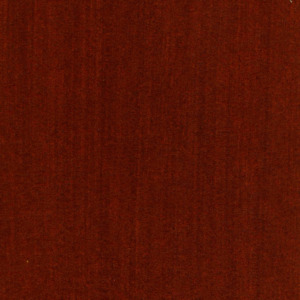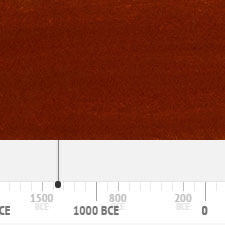Burnt Umber
Natural organic pigmentComposition and Properties of Burnt Umber
Umber is a general designation for a sedimentary mineral substance containing between 5 to 20% manganese oxides and hydroxides and a larger percentage of iron oxides. The higher content of manganese oxides compared to ochres is responsible for the brownish colour. The calcinating or burning corresponds to heating the material with the purpose of removing water molecules from the crystal structure. This procedure results in a shift of the colour towards warm brown.
Iron oxides can withstand high temperatures but are not resistant to acids. The pigment is stable although there were reports on changing colour over time during the Renaissance period. It is compatible with all other pigments and is often used to darken other pigments in shadows.

Pigment

Painted swatch
Video: 'Raw & Burnt Umber' by In Liquid Color
Video: 'Why Burnt Umber is an essential pigment for artists' by Draw Mix Paint
Names
Alternative names
Mineral brown
Color Index
PBr 7, CI 77492
Word origin
From Middle French ombre (in terre d’ombre), or Italian ombra (in terra di ombra), both from Latin umbra “shade, shadow”
From Online Etymology Dictionary
Gebrannte Umbra
German
Terre d’ombre
French
Terra d’ombra
Italian
Tierra de sombra
Spanish
Preparation
Umber can be found in nature with the largest deposits in Cyprus. Burnt umber is prepared by heating raw umber until it is a reddish-brown color.
References
(1) Cornell, R. M., & Schwertmann, U. The Iron Oxides: Structure, Properties, Reactions, Occurrences and Uses. Wiley 2006
(2) Helwig, K. Iron Oxide Pigments, in Berrie, B.H. Editor, Artists’ Pigments, A Handbook of Their History and Characteristics, Volume 4, pp. 38-109.
History of Use
The pigment had been in use since antiquity.
Examples of use
El Greco, Portrait of Jorge Manuel (Artist’s Son), ca 1603

2 Dark hair, eyebrows, and beard: burnt umber mixed with a copper-containing pigment. The x-ray fluorescence only allows the identification of specific elements but not the exact chemical composition of the pigment. The copper-based pigment could thus be blue azurite or green verdigris or malachite.

Identification
Raman Spectrum
(1) Froment, F., Tournié, A., & Colomban, P. . Raman identification of natural red to yellow pigments: ochre and iron-containing ores. Journal of Raman Spectroscopy, 39(5), (2008) 560–568. doi:10.1002/jrs.1858
X-Ray Fluorescence Spektrum (XRF)
XRF Spectrum in the Free XRF Spectroscopy Database of Pigments Checker, CHSOS website.
Further Reading
References
(1) Helwig, K. Iron Oxide Pigments, in Artists’ Pigments, Berrie, B.H., Ed., National Gallery of Art Washington, 2007, pp 38 – 109.
(2) Cornell, R. M., & Schwertmann, U. The Iron Oxides: Structure, Properties, Reactions, Occurrences and Uses. Wiley 2006.
(3) Earth pigments tour website. Contains a colour map of many earth pigments.
(4) Hradila, David; Grygara, Tomáš; Hradilová, Janka; Bezdička, Petr. Clay and iron oxide pigments in the history of painting. Applied Clay Science 22, 2003, p. 230.
(2) S. Muntwyler, J. Lipscher, HP. Schneider, Das Farbenbuch, 2nd. Ed., 2023, alataverlag Elsau, pp. 32-35.



